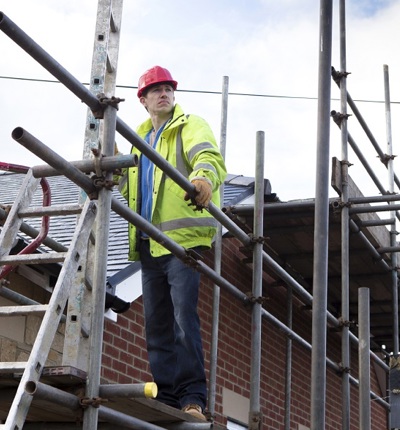
Construction workers - worked to death?
Ross Whalley a lawyer specialising in injuries at work, examines the latest statistics from the HSE and asks why more isn't being done to improve safety where workers are most at risk, within the construction industry.
Posted on 06 December 2019
On 30 October 2019, the Health and Safety Executive (HSE) published its annual report, Health and Safety at Work, summary statistics for Great Britain 2019
The report details the number of workplace injuries, work-related ill health issues, working days lost, enforcement action taken and the associated costs to the country.
The HSE provides statistical reports from individual industry sectors. Across all these industries, around 581,000 workers sustained non-fatal injuries over twelve months, between 2018 and 2019 with 1.4million workers suffering from work-related ill-health. These estimates are based on self-reports from the Labour Force Survey. As such, any non-reported matters are not included within the statistics.
The estimated economic cost of work related injury and ill health to the UK economy totalled £15 billion in 2018.
Most worryingly, those sectors which have the highest risk of people sustaining an injury while at work, including construction and agriculture, are still amongst the most high-risk sectors with little or no improvement in these statistics.
Construction
HSE’s construction industry statistics indicate that there were 54,000 non-fatal injuries in construction. This is decreasing but only slightly and is still significantly higher than the all industry average; around 2.4% of workers in the construction industry sustained non-fatal injuries compared to the all industry rate of 1.7%.
Leigh Day act for a number of people injured at work including Mr M who was driving a JCB on a construction site when it toppled over crushing his lower body and right arm.
He suffered catastrophic injuries and spent over 11 months in hospital undergoing treatment for complicated pelvic injuries and serious crush injuries to both legs and his right arm.
We were able to settle his claim for a seven-figure sum. The employer was held liable for a lack of adequate training and defective equipment.
Construction invariably involves the use of heavy machinery and difficult working environments, which are likely to continue to cause above all industry average statistics. Despite the complexity and magnitude of many construction projects, it is disappointing that the most common breaches of safety are so often basic errors, as was the case with Mr M.
Fatal injuries
HSE’s construction industry statistics indicate that there were 37 fatalities in 2019; 30 workers and 7 members of the public were killed. This remains stubbornly consistent with the average over the last 5 years of 36 fatalities to workers and 5 to members of the public.
It is a huge concern that the fatal injury rate for construction is three time the all industry average.
Amongst those bereaved families that Leigh Day has helped are the family of Kieron Deeney who was killed on a Laing O’Rourke building site at Canary Wharf when a hatchway he was standing on gave way.
The team at Leigh Day secured a settlement for Kieron’s widow Jennifer Deeney, after it was proved that the access hatch had been covered with a rotten piece of plywood.
The jury at the inquest into Kieron’s death delivered a verdict of unlawful killing. Jennifer became a campaigner on the importance of safety culture and gives up much of her spare time to raise awareness of health and safety on construction sites.
The evidence at the inquest established that, although the cover had been in place for two to three weeks beforehand, there was no form of safety inspection as the project was still under construction.
A rudimentary breach, that someone should have checked the work involved in covering the hatch, led in this case to tragic consequences.
Falls from height
Of the 30 recorded fatal injuries to construction workers in 2019, it is notable that 49% of these were falls from height, a hazard that continues to blight the sector.
Construction is significantly above the all industry average for accidents involving falls from height; 18%: 8% respectively.
Leigh Day acted for Mark Wright, a 50-year-old self-employed builder. Mark suffered severe spinal injuries after falling 15 foot through an unguarded skylight whilst working on the roof of a house in London. The team were able to settle his claim for a seven figure sum.
Here, a failure to provide protective barriers, such as roof edge protection or scaffolding, around holes that had been cut into a flat roof led to a serious injury which could have been avoided.
Mental and physical ill health
It is important not to just consider injuries but general ill health too. This can be more difficult to measure but as the statistics show, the numbers are much higher. These statistics cover musculoskeletal disorders, respiratory diseases, contact dermatitis, occupational cancers and mental health issues.
In August 2019, the Guardian reported on a mental health crisis at the Hinckley Point C site. Two construction workers have taken their own lives during the project.
Officials from the Unite union indicated that they were told of 10 suicide attempts in the first four months of 2019 as well as a rise in the number of people off sick with stress, anxiety and depression, and an increase in workers suffering from mental distress.
There has been criticism of HSE for not including work-related suicides within their statistics. Low skilled male labourers, particularly those working in construction, had a risk that was three times higher than that the average for England; men working in skilled construction jobs also had an increased risk.
The construction industry is often split into tiers of subcontractors trying to make tight margins and deadlines, even if a principal contractor has ambitions about protecting workers, that does not always trickle down the supply chain.
International
Obviously, HSE’s statistics are based solely on the UK. To give a fair frame of reference, consideration should be given to construction worker statistics internationally too.
Construction of London’s Olympic Park was completed without a single death and won an award for safest Olympic Stadium build ever completed. More than 12,500 workers helped construct the venues and the ‘Big Build’ of the site has been hailed as the safest construction of an Olympic Stadium ever.
This is in stark contrast to the 10 deaths during Beijing 2008 and 14 deaths at the Greece Olympics in 2004.
Qatar has also recently embarked on largescale infrastructure projects in readiness for the 2022 Football World Cup. Reports from 2019 indicate that approximately 1,200 construction workers have died since 2010.
Conclusion The UK has historically been amongst the most progressive nations for occupational health, having one of the lowest rates of fatal workplace injury, compared to other large EU countries.
The 2019 HSE statistics show trends in variation but an overall general stability in the figures. There is still much work to do to improve construction workers health and safety, especially given reports of tragic consequences from such remedial safety breaches.
Every worker should be healthy and safe at work. Every fatality and injury is one too many.
This blog was prepared with the assistance of Supriya Banerjee-Halliday, paralegal in the personal injury team at Leigh Day


